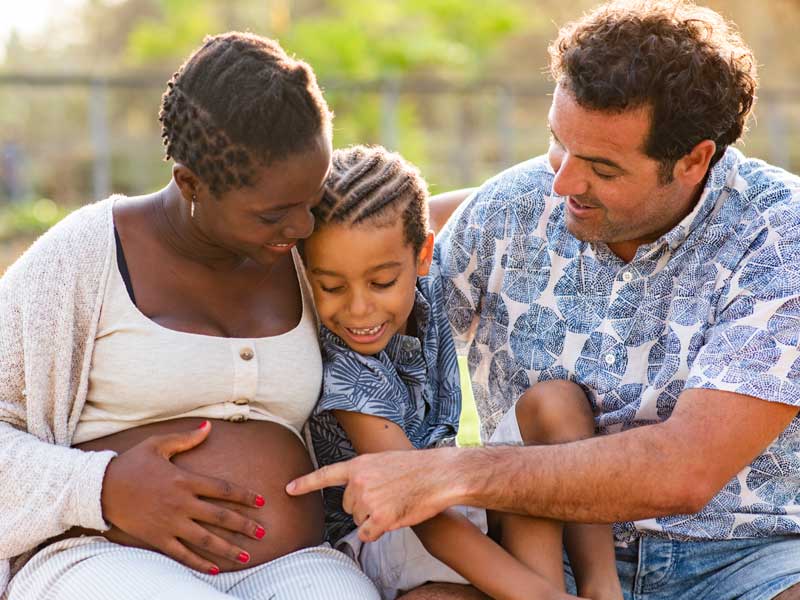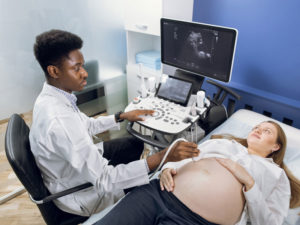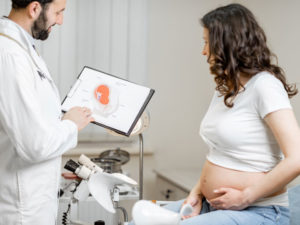
Feeling less tired and more energetic as your baby bump starts to show up? Welcome to your second trimester of pregnancy – the “golden” one!
A pregnancy lasts, on average, 40 to 42 weeks and is divided into three distinct trimesters, each roughly spanning 14 weeks. Lasting from weeks 13 to 26, the second trimester of pregnancy is usually that sweet spot when an energy boost may replace the morning sickness from the first three months and when you’ll finally feel your child moving.
In our guide to your second trimester, we’ll tell you why this is often considered the best moment of pregnancy. We’ll also explore the crucial physical and emotional milestones and provide a comprehensive checklist for the second trimester.
Table of Contents
Which Trimester is the Hardest? A Timeline Summary
Important Milestones of the Second Trimester
Second Trimester Checklist: Your Baby’s Development
What Care Do You Need in Your Second Trimester?
Which Trimester is the Hardest? A Timeline Summary
We believe each trimester brings its own challenges and joys so we leave it to you to decide! Here’s what to expect in each trimester:
First Trimester of Pregnancy: Weeks 1 to 12
Symptoms:
- Nausea
- Morning sickness
- Fatigue
- Breast tenderness
- Frequent urination and vaginal discharge
- Mood swings
- Perhaps experiencing food aversions and heightened sensitivity to smells
Transformations:
The first trimester is a crucial period of fast development for your embryo as major organs and body systems begin to form. For this reason, it’s often considered the most critical regarding potential risks and pregnancy complications.
Your uterus increases in size to accommodate your growing embryo, and hormonal changes may trigger many physical and emotional adjustments for you.
Second Trimester of Pregnancy: Weeks 13 to 26
Symptoms: Many women find relief from early pregnancy symptoms during the second trimester, although new ones may arise, including the following:
- A visible “baby bump”
- Increased energy levels
- Reduced nausea
- Decreased frequency of urination
- Heartburn
- Backaches
- Leg cramps
- Nasal congestion
Transformations:
The second trimester of pregnancy is often called the “honeymoon phase,” marked by a sense of well-being and excitement. Your weight gain becomes more noticeable as the infant grows and your uterus continues to expand.
Fetal movements, known as “quickening,” typically begin around the middle of this trimester, providing a tangible connection between you both. This is also when you’ll be able to discover your baby’s sex if you wish.
Additionally, many prenatal tests and screenings may be conducted to monitor your baby’s health and development. More on this below.
Third Trimester of Pregnancy: Weeks 27 to 40 (or until birth)
Symptoms: As the due date approaches and your body prepares for giving birth, you may experience increased discomfort due to the size of your belly. Common symptoms include:
- Shortness of breath
- Backaches
- Sudden swelling of the feet and ankles (edema)
- Frequent urination
- Difficulty sleeping
- Braxton Hicks contractions (practice contractions for birth)
Transformations: The third trimester is a time of final preparation and anticipation as your newborn’s arrival approaches. Baby movements may become more pronounced and prenatal visits more frequent.
Your body prepares for giving birth through cervical dilation while your baby settles into a head-down position in readiness for delivery.
Now, let’s dive into the second trimester, the transitional phase of pregnancy. When does second trimester start? What are the milestones you’ll experience during this period? Read on to find out.
Important Milestones of the Second Trimester
As mentioned, the second trimester of pregnancy lasts from weeks 13 to 26 and is crucial for several reasons.
It marks a period of relative relief from the intense symptoms you may have experienced during the first trimester, like morning sickness. It also heralds the emergence of exciting milestones and developments for both of you.
Here’s why the second trimester of pregnancy is so important:
Visible Tummy
Around 12-16 weeks, you may begin to notice a visible projection of your abdomen as your uterus expands to accommodate your growing baby. This is often when it becomes more apparent that a new life is developing within you. Talk to your doctor about how much weight you should put on during this phase.
Fetal Movements (Quickening)
Feeling your baby’s movements for the first time in the second trimester is exciting. Typically, this occurs around 16-20 weeks and is known as quickening.
These gentle flutters or kicks serve as a tangible reminder of the growing presence of your child.
Energy Boost
Many women experience a surge of energy during the second trimester and a welcome relief from the fatigue that often accompanies the first one. This increase in energy can help you enjoy a greater sense of well-being.
It’s also a great motivator for keeping to a healthy lifestyle and engaging in physical activity. Staying active during pregnancy has numerous benefits, including improved mood, reduced discomfort, and better overall health.
However, choose safe and moderate exercise for this second trimester. Here’s a list of safe activities for reference.
Pregnancy Exercises – Second Trimester
- Walking
- Swimming
- Prenatal yoga
- Pilates
- Strength training
- Pelvic floor exercises (Kegels)
Prenatal Screening and Testing
During the second trimester, you’ll likely undergo many prenatal screenings and tests to assess your baby’s health, genetic conditions, and development. This may include ultrasound scans, genetic testing, and screenings for conditions such as gestational diabetes.
What Does a Growth Spurt in Pregnancy Feel Like in the Second Trimester?
You’ll typically experience a noticeable growth spurt during the second trimester. Because your baby is undergoing rapid growth and development, you’ll notice a significant increase in the size of your uterus and abdomen, leading to visible changes in your body shape.
This growth spurt is often accompanied by a surge in energy and increased appetite. You may also notice other physical changes, such as breast enlargement and changes in your skin pigmentation, including stretch marks and darkening of the skin.
Emotional Changes and Mental Health Considerations During Second Trimester
Emotionally, this period can be a mix of excitement, relief, and occasional anxiety as you adjust to the evolving realities of pregnancy. And while many women experience a boost in mood and energy during the second trimester, others may encounter new challenges or fluctuations in their emotional well-being.
If that’s you, it’s crucial to talk honestly with your healthcare provider and support networks to help you manage these emotions and ensure a positive pregnancy experience.
So, consult your doctor or healthcare provider if you experience any of the following during your second trimester:
- Persistent feelings of sadness, hopelessness, or anxiety
- Difficulty sleeping or changes in appetite
- Loss of interest in activities you once enjoyed
- Thoughts of harming yourself or the baby
- Excessive worry or stress that interferes with daily functioning
- Any concerning physical symptoms such as severe abdominal pain, vaginal discharge or bleeding, or changes in fetal movement patterns
Second Trimester Checklist: Your Baby’s Development
The second trimester of pregnancy is a moment of significant growth and development for your baby, marked by increased movement, refinement of sensory abilities, and the establishment of sleep-wake patterns.
You may not feel pregnant at 13 weeks because you can’t see or feel much happening to your baby before the second trimester starts. But the following milestones happen rapidly during the second trimester of pregnancy. They lay the foundation for further development and maturation in the third trimester and beyond.
During this second trimester you’ll definitely feel pregnant! So, here’s how your baby will grow and develop during the three months of your second trimester.
Week 13-14:
Movement: Your baby’s limbs are developing and becoming more coordinated. Although still small, your baby may begin to make tiny movements, though you may not feel them yet.
Hearing: Your baby’s inner ear structures are forming, and they may start to detect sounds from the outside world, such as your heartbeat and digestive noises. So, now it’s a great moment to start talking and singing to your baby.
Sleep Patterns: Your baby begins to develop sleep and wake cycles – although these patterns probably don’t yet synchronize with yours! They may alternate between periods of activity and rest.
Size and Weight: From now on, fetal development is fast. By the end of the 14th week, your baby is approximately the size of a lemon, measuring about 3.4 inches long and weighing about 1.5 ounces.
Week 15-16:
Movement: Your baby’s movements become more frequent and pronounced. They may begin to kick, stretch, and make jerky movements, which you may feel as fluttering sensations.
Hearing: Your baby’s ears continue to develop, and they may start to respond to external noises, such as your voice and music.
Sleep Patterns: Your baby’s sleep cycles become more structured, with periods of deep sleep alternating with periods of REM (rapid eye movement) sleep.
Size and Weight: By the end of the 16th week, your little one will now be the size of an avocado – approximately 4.6 inches long and 3.5 ounces.
Week 17-18:
Movement: Your baby’s movements become more coordinated and purposeful. They may start to explore their surroundings by touching their face and grasping the umbilical cord.
Hearing: Your baby’s hearing abilities continue to develop, and they may start to respond to familiar voices by turning their head or increasing their activity level.
Sleep Patterns: Your baby’s sleep patterns are becoming more regular, with longer periods of quiet sleep and shorter periods of active sleep. They may also start to exhibit more consistent movement patterns during wakeful periods.
Size and Weight: Your baby is now approximately the size of a pear, measuring 5.6 inches and weighing about 6.7 ounces.
Week 19-20:
Movement: Baby’s movements are now more defined, and you’ll be able to feel them more often. They may start to respond to external stimuli, such as a light touch or pressure on your tummy.
Hearing: As your baby’s ears mature, they may respond to a broader range of sounds, including voices, music, and environmental noises.
Sleep Patterns: Your baby’s sleep-wake cycles become more established, with distinct periods of activity and rest. They may even dream and exhibit more complex movements and behaviors during wakeful periods.
Size and Weight: By the end of the 20th week, your baby’s body is getting in shape and is approximately the size of a banana – 6.5 inches long and 10.6 ounces.
Week 21-24
Movement: The movements are now more coordinated and purposeful. Your child may begin to practice breathing movements, though actual breathing does not occur yet.
Hearing: As the hearing sense continues to improve, they may recognize and respond to familiar voices or sounds, such as yours and their dad’s.
Sleep Patterns: The sleep cycles become more structured, with distinct periods of REM (rapid eye movement) sleep and non-REM sleep.
Size and Weight: By the end of the 22nd week, your little one is approximately the size of a papaya, measuring about 11 inches long and weighing about 1 pound.
These developmental milestones give you a general glimpse into your baby’s growth and maturation during your second trimester. However, each pregnancy is unique, and so is your baby’s growth development.
Now, let’s have a look at how you can benefit from your energy boost to do some essential things in your second trimester.
What Care Do You Need in Your Second-Trimester?
The second trimester is the best time during your pregnancy to take action to ensure a healthy and comfortable pregnancy experience while preparing for the arrival of your new baby. Here are some ideas to inspire you:
Medical Care in Second Trimester of Pregnancy:
- Schedule and attend important regular prenatal bloodwork, ultrasounds, and check-ups with your healthcare provider.
- Discuss any concerns or questions about your pregnancy with your doctor.
- Schedule and attend any recommended prenatal screening or test, such as ultrasound scan, genetic screening test, and test for gestational diabetes.
- Discuss your birth plan and preferences with your healthcare provider.
Nutrition and Wellness in Second Trimester of Pregnancy:
- Maintain a balanced diet rich in fruits, vegetables, whole grains, lean proteins, and healthy fats.
- Continue taking prenatal vitamins as recommended by your healthcare provider.
- Stay hydrated by drinking plenty of water.
- Engage in regular physical activity.
- Practice stress-reduction techniques like relaxation exercises, deep breathing, and mindfulness.
- Get plenty of rest and prioritize quality sleep throughout pregnancy.
Self-Care in Second Trimester of Pregnancy:
- Invest in comfortable pregnancy clothing that accommodates your growing belly.
- Purchase a supportive pregnancy bra to accommodate breast changes and provide comfort.
- Practice good posture to alleviate back pain and discomfort associated with pregnancy.
- Use pregnancy pillows or support cushions to improve comfort while sleeping or sitting.
- Incorporate relaxation techniques, such as prenatal massage, warm baths, or meditation, to alleviate stress and promote relaxation.
Preparation for a Newborn in Second Trimester of Pregnancy:
- Start researching and preparing for birth or breastfeeding classes if desired.
- Begin planning and setting up your baby’s nursery, including choosing furniture, decorating, and organizing baby essentials.
- Create a registry and start gathering necessary items, such as clothing, diapers, gear, and feeding supplies.
- Consider taking maternity leave or arranging work accommodations for after your baby arrives.
- Discuss childcare options and maternity leave plans with your employer and partner.
- Consider attending a hospital tour or meeting with your healthcare provider to discuss birth and delivery preferences.
Experience Exceptional Prenatal Care with Stella Mattina
At Stella Mattina, we specialize in women’s healthcare including all aspects of ObGyn. As you journey through your second trimester of pregnancy, Stella Mattina can offer you specialized prenatal care that prioritizes your well-being and the health of your newborn.
Why not entrust your second trimester to our experienced team of compassionate healthcare professionals?
Schedule your consultation today and let’s talk.
Dr. Krum is currently in practice in Arlington, TX. He received his undergraduate degree at Texas A&M University, then attended UTMB Galveston for medical school, finishing in 1986, completing his residency there in 1990. Providing a full range of obstetrical and gynecological care, he specializes in the treatment of endometriosis and robotic surgery. He arranges his schedule so that same-day appointments are usually available.







